Abraham Chintianto: HM of the Market 2.0

+ Abraham Chintianto 🇮🇩
Honourable Mention of the Market 2.0: Circular Economy Hub
Portfolio: https://www.non-a.com/members/abrahamchnt/portfolio/
Instagram: https://www.instagram.com/nonprobram/
1) Could you briefly introduce yourself?
Abraham Chintianto is an architectural designer and research assistant at the Architecture Design Lab in Universitas Indonesia. He earned his Bachelor of Architecture degree, with honors, at Universitas Indonesia, and was awarded an award for environmental consciousness for his final project. His current works are primarily on community and commercial architectural projects across various scales, while also participating in various research, teaching, competitions, events, and community engagement projects.
A long time admirer of the fascinating yet powerful nature of the design realm, Abraham understands the responsibility that comes along within design as a medium of innovation for our society. He is particularly interested in visual narratives, speculative thinking, and system-making that have a peek into the future but stand above today’s grip. Transcending across art, design, and technology, Abraham believes in interdisciplinary collaboration at the foundation of every visionary works. Through this spatial language that is common to the eye, Abraham is beyond excited and proud in taking part to explore a provocative, contextual, and responsible tomorrow.
2) What inspired you for the Market 2.0?
I always believe that a sustainable future is for everyone and everywhere, hence it can start with everyday activity. My proposal for the market 2.0 focuses on eliminating the burdensome plastic-centric packaging, excess food, and promotional leaflets that are currently not circular thus haunts many of the traditional markets around the world. The solution to this comes in the form of a market interspersed with bamboo farms. The bamboo -as one of the plants with the highest growth rate- can produce leaves suitable for single use and quick disposable packaging, while the stems are a suitable material for plates, baskets, and other shopping-supporting equipment.
One third of the market areas are dedicated for upcycling stalls that focus on repairing customer’s needs, while also providing the bamboo-based utensils. This extensive bamboo plantation catches direct sunlight while also shading the surrounding stalls, watered by rainwater gathered from the roof, and is fertilized from the residue of a series of biogas digesters. Cooking activities are fueled by gas coming from digested excess food and dry leaves while promotional posters and leaflets are made from recycled cardboard and paper packaging.
3) Can you describe any particular challenges you faced during the design process and how
you overcame them?
One major obstacle that I personally faced during this competition is the urge to create unique solutions with a strong identity and selling points, and one way to overcome it is by being aware of our surroundings. Sustainable topics have been a popular conversation in recent years, with plenty of systems and solutions becoming more and more common. Finding fresh ideas might require us to pay more attention to our surroundings, of how things work, and we might find something interesting that we were not aware of before. It can be something simple and of low-technology, something that nature already offers, or something that our society has long practiced. From there, we can develop contextual ideas that are familiar to our community and surroundings.
4) How do you think your educational background or professional experiences influenced your winning design?
I believe both educational and professional experiences have their own role in the design process of an architecture competition. Educational background provides me with a new paradigm and various design approaches as practiced in the design studio, offering flexibility in responding to each unique competition challenge. On the other hand, professional experiences give insights on practical, context-awareness, and various on-site knowledge and not to forget current, past, and future projects that serve as a precedent.
5) What advice would you give to students or young professionals looking to excel in architecture competitions?
Be freed, bold, and have fun! My colleagues and I often say that an architecture competition is a luxury, it’s a privilege, to be free and express any of your wildest ideas. There’s a minimum of boundaries and all those (sometimes boring) building codes that you have to consider, so what’s there to worry about? In addition, doing competitions with fellow friends is also a fun opportunity to spend time and have a deep-yet-relax talk or sketching session about your big visions that can spread onto various other unique topics.
6) What are your future aspirations in the field of architecture?
I believe the future of the architecture field lies in interdisciplinary collaboration. We, as an architect and designer, need to lower our ego in trying to listen and understand every other discipline to achieve a more holistically impactful product for everyone. Inspiration can come from everywhere and everyone, thus we shall welcome each new opportunity, technology, and insights, even the simplest one, with open arms. Only then, we can together design a better, collaborative, and responsible tomorrow.


Common Ground: Creating Impact without Leaving One



Responses